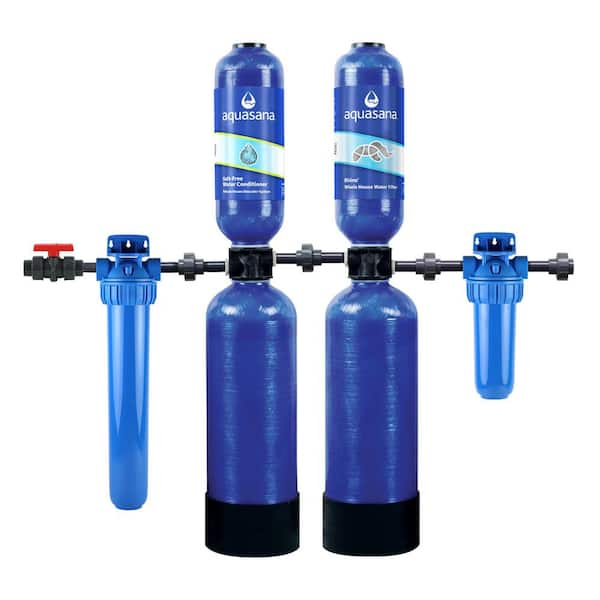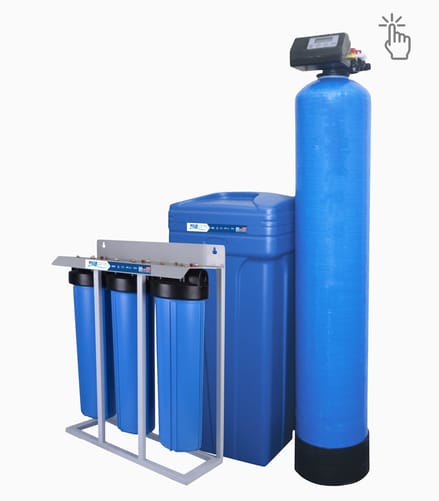Table Of Content

Despite the premium price of this 48,000-grain-capacity water softener, DuraWater’s model is an excellent investment for a medium to large household. This salt-based water softener removes magnesium, calcium, and even traces of iron to protect pipes, clothing, and hair from the effects of hard water. Water softeners are the only systems that can reliably and efficiently deliver soft water to your whole home. While salt-free water softeners can mitigate some effects of hard water, they do not actually soften water, leaving you with dry skin, streaky dishes, and brittle hair. It is a process using which the water softener removes the hardness causing minerals it caught from the previous supply of hard water – so that it can continue to soften more water as it arrives. Aquasure’s dual-tank water softener is known as one of the best hard water softeners for a well system, with a high-capacity 48,000-grain tank that’s suitable for homes with up to five people.
When to Replace Your Whole House Water Softener
You might think that it won’t remove hardness but as the NSF Standard 169 certification of this water softener shows, it’s pretty good at removing hardness from your water. Instead, it uses commercial technology which prevents the buildup of minerals in your pipes and minerals. As for its filtration, this system uses a carbon black filtration cartridge which helps remove sediments, taste, and odor from your drinking water. The Aquios AQFS220 is one of those whole-home water softeners which doesn’t rely on salt to remove the hardness of your municipal water and also provides a filter system in its package. First things first, the fact that this water softener comes with no smart features means it won’t blow a hole in your pocket.
How Does a Whole House Water Filtration System Work?

Once the resin beads are filled to capacity, the salt pellets cleanse the beads, replacing the mineral ions with salt ions—hence why softened water often has a higher salt content. Eventually, this will cause the pellets to dissolve and they’ll need to be replenished. As its name implies, a water softener is a filtration system that works to remove all impurities from water which are the reason for its hardness.
Dual-Tank Water Softeners
There are just two main plumbing connections, which made the process easy – we actually installed this one ourselves and think it’s much more DIY-friendly. We installed the unit in a home on municipal water in the mountains of Colorado. Like the SpringWell Futuresoft, the Kind E-2000 uses template-assisted crystallization, so it reduces scale without softening water in the technical sense.
Occurs when water passes through the mineral tank where positively-charged calcium and magnesium ions are exchanged with sodium onto the negatively-charged resin beads. The calcium and magnesium are retained on the media within the resin tank while the remainder of the water with sodium ions flows into the home, resulting in softened water. Eventually, all sodium ions are exchanged with the magnesium and calcium on the resin beads fill with calcium and magnesium and need to be regenerated. Others require a new plumbing loop that directs the softened water only to the necessary indoor areas of the home. A soft water loop has multiple long-term benefits, including extending the life of the water softener and preventing mineral buildup.
🚰Why do I need a water softener & What are the benefits of water softening system?
A typical water softener is made up of a tank that connects to your water-supply line. The tank is filled with resin beads, and on top is a brine tank, which can be filled with salt or potassium chloride pellets. As the water enters the tank, it runs through the resin, which has a negative charge and draws out the positively charged minerals in the water.
Brine Tank
In a counter-current cycle, the most highly charged beads will be at the bottom of the tank, right before the water exits into the house. Systems that use this process are known as high efficiency water softeners. Many whole house water filters offer water softening as a byproduct of filtering.
My Quest for Pure Water - The New York Times
My Quest for Pure Water.
Posted: Thu, 05 Mar 2020 08:00:00 GMT [source]
Hard water can dry out your skin and hair, leaving them feeling rough and brittle. Soft water, on the other hand, can help to improve the quality of your hair and skin by making them softer and more hydrated. To keep the system working properly, you need to add salt to the system on a regular basis. The amount of salt you need to add will depend on the size of your system and the hardness of your water. We’ll cover the different types of filtration systems available, how they work, the benefits of using one, and what to look for when making your purchase. Standing at 22 inches tall and 10 inches wide, it can accompany you almost anywhere.
The Econominder 5600 is tested by ANSI/NSF Standard 372 to prove its lead-free compliance. It is also certified by both the WQA as well as NSF/ANSI Standard 44 for its softening performance. The only way to avoid these hard water problems is to install a whole-house water softener. The type of technology can impact the initial as well as long-term maintenance costs of a water softener.
The most effective way to remove sodium from water without using an alternative salt is a reverse osmosis system. These systems remove almost all sodium from water in addition to almost all other contaminants. Reverse osmosis systems are point-of-use filtration systems, meaning their installation can be localized to treat the water you are using to drink and cook with. This means water that flows from your other fixtures still contain sodium that can cause ill effects in your septic tank. If you must remove sodium from all water in your home, consider a whole-house reverse osmosis system. Water softeners can last as long as 20 years, but the average lifespan is 15 years.
There are a number of different types of whole house water filters which focus on filtering different contaminants based on the type of filter media they contain. Contaminants removed – The Matrixx Infusion utilizes chemical injection and oxidation processes across four stages, ensuring efficient removal of iron and sulfur. Hydrogen peroxide is injected into the water, oxidizing the minerals, which are then effectively filtered out using a coconut shell catalytic activated carbon media. The automatic backwashing feature efficiently removes the oxidized minerals, enhancing overall performance. Designed to cater to various flow rate requirements, the Matrixx Infusion offers options ranging from 10 GPM to 25 GPM, ensuring an adequate supply of treated water for households of different sizes. With a remarkable capacity of up to 1 million gallons, this system provides long-term filtration without compromising performance.
A bypass valve enables you to divert water from the softener system, which can be useful in a number of situations. When turned on, the valve will direct the flow from your water pipe past the softener system—enabling you to work on the softener without shutting off water to the whole house. A bypass valve is also sometimes useful when using a volume of water where water hardness is not an issue. For example, if you’re doing yardwork it might make sense to divert water from the softener. Doing so saves the resin media from filtering water unnecessarily and shortening the time until the system’s next regeneration cycle. This is one of the best water-softener systems available at an affordable price, making it an attractive solution for hard-water problems in average-size homes.
It is especially important to make sure your water softener is located before your water heater, as hard water does the greatest damage to hot water appliances. You will want to install the softener in a dry, level location like a basement or garage. The system should be close to the water’s main line, an electrical outlet to power the system, and a drain for the brine solution from the regeneration cycle.
Installing a whole-home water softener costs an average of $1,500 but could range between $500 and $6,000. Water softeners remove the minerals from hard water, giving your water a more pleasant feel right out of the tap. We’ll break down the cost of a water softener system, types of water softeners, and money-saving tips below. Not everyone can or wants to spend upwards of $1,000 for a water softener, but clogged pipes can lead to an even costlier catastrophe. This means that it will protect your pipes and appliances from buildup, but it doesn’t actually remove the minerals from the water. It’s a low-maintenance device that doesn’t require any additional pellets or solutions, and can last up to two years before needing a replacement.
This process can continue consistently as long as you regularly top up the salt in the brine tank. Salt-based water softeners are a familiar sight in homes supplied by hard water. A popular and affordable salt-based softener for average-sized households is the Rheem Preferred 32,000 Grain Water Softener. We discovered that water softener capacity is usually indicated by how many particles the system can filter before needing a regeneration cycle. An average-sized water softener for three to four-person households is usually in the range of 32,000 to 40,000 grains. The bigger the grain capacity, the fewer number of times a softener has to regenerate (which saves water).

No comments:
Post a Comment